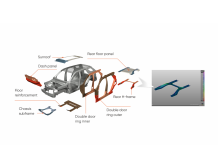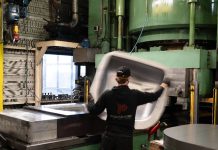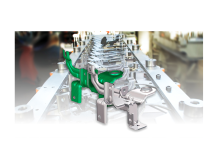Robustness – what is it and how does it relate to strawberry pies?
In several previous posts we have talked about robustness and the repeatability of processes, and how the process might vary in its output relative to the changing input parameters. And we realize that we have not actually discussed in any detail precisely how you can recognize this variation.
Variation of a stamping process is measured in attributes like splits, wrinkles, fitting of a fixture. This variation has been expressed using images which display color plots with classic traffic signals.

AutoForm-Sigma result indicating unacceptable failure rate
Robustness of a process and the variability of the output quality that might arise when faced with un-intended input variation is an abstract idea for many in our industry.
Metaphors always help explain abstract ideas, so as a first explanation attempt let’s discuss our latest trip to the market to buy fresh strawberries. The strawberries are intended for a strawberry pie. The recipe that we found on the internet requires 500g of fresh strawberries. At the market there is a vendor selling 500g packages of strawberries – great!

Incoming Strawberries
In absolute terms if I buy any box of strawberries for which I pay for 500g, I believe I am getting 500g. I usually assume that I pay for what I get, and since I pay for 500g I have faith that 500g is what I will take home for my pie. When arriving at home, the strawberries are added with the remaining ingredients as the recipe outlines. Processed in the oven for the correct time and the results are less than expected.
 The question is where did we go wrong? There are many potential sources for the variation from a planned or intended result in this case, from the strawberries to the execution of the recipe’s instructions. Can we blame the recipe (engineering) or is it the materials (bad strawberries, too many, too few strawberries) or any other ingredients and their combination?
The question is where did we go wrong? There are many potential sources for the variation from a planned or intended result in this case, from the strawberries to the execution of the recipe’s instructions. Can we blame the recipe (engineering) or is it the materials (bad strawberries, too many, too few strawberries) or any other ingredients and their combination?
We can’t come to any clear judgment it until we actually understand what those inputs (ingredients qualities and quantities) really were. Let’s focus on the strawberries first, but bear in mind other aspects of the recipe would also require similar scrutiny eventually.
If we assume that the strawberry mass was the most influential input that led to the poor pie performance we might conclude that the recipe could be adjusted to account for using fewer of the 500g of strawberries. And we might go to the market, buy another package of strawberries and this time the pie could be too dry.

Assumed reliability of mass of package of strawberries
These two batches of strawberries might have been the only two outliers among all the strawberry containers at the market. But realistically, it is more likely that the strawberries display typical variations in the delivered mass.

Distribution of actual reliability of mass of package of strawberries
The farmer intended to make good on the promise of the specified mass of strawberries, but the process by which the strawberries are added leaves some room for unintended process variation. Such process variation is natural and normal. Strawberries that occur organically in the world are not homogeneous in size and shape, and they might have more or less moisture content, or just fit in the container differently.
If there was a way to assure that our recipe could account for such variations, then this would be highly valuable to us. If we could accurately evaluate the quality of pies and account for ranges of acceptable mass variation, then we would have a better recipe.

Mass variation range for incoming strawberries
is likely to produce the least variation in pie quality?
The recipe may have been correct the whole time. The presumption that the strawberries are delivered at the specification mass might be the flaw.
How often do we as engineers assume that the ordered specification is exactly what is delivered? Some might argue that we should have re-weighed the strawberries and precisely controlled the strawberry content. However, in this analogy as it relates to stamping there are many input variables which cannot be directly controlled on the shop floor. Yet they still have to be accounted for. Input parameters with such unintended variations include material thickness, mechanical properties of the sheet metal, lubrication, blank holder force, blank location, just to name a few that we have mentioned in previous blog posts. Their unintended variation can cause unexpected part quality issues, increases in scrap rates and production down times during the manufacturing process.
Wouldn’t it be good to know if our strawberry pie will “nail it” or fail – before we make it?
Find out more how to “nail” it in our earlier blog post here:














Muy buen breve informe de tener en cuenta algunas de las variables de carga de entrada. Pero es más complejo. Y una variable que aún no representa es la temperatura en cadencia solo da de la primera pieza.
verry nice parallel to what in fact happens in the all day stamping workshop….yet, there are manny debates about the coil quality, stamping conditions, temperature……but this is still verry nice written;